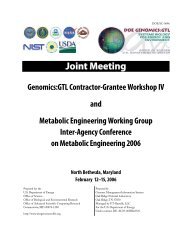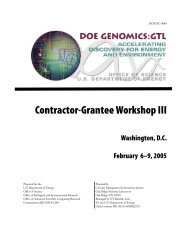Joint Meeting - Genomics - U.S. Department of Energy
Joint Meeting - Genomics - U.S. Department of Energy
Joint Meeting - Genomics - U.S. Department of Energy
Create successful ePaper yourself
Turn your PDF publications into a flip-book with our unique Google optimized e-Paper software.
24<br />
Systems Biology for DOE <strong>Energy</strong> and Environmental Missions<br />
sion vector based on this novel signaling system whereby<br />
varying the amount <strong>of</strong> signaling molecule provided as the<br />
inducer can control gene expression levels over a dynamic<br />
range. We anticipate that we will be able to combine<br />
new information about mechanisms <strong>of</strong> electron flow<br />
to nitrogenase with the use <strong>of</strong> our new gene expression<br />
system and other tools to improve rates <strong>of</strong> H 2 production<br />
by R. palustris.<br />
References<br />
1. Oda, Y., S. K. Samanta, F. E. Rey, L. Wu, X. Liu, T.<br />
Yan, J. Zhou, and C. S. Harwood. 2005. Functional<br />
genomic analysis <strong>of</strong> three nitrogenase isozymes in<br />
the photosynthetic bacterium Rhodopseudomonas<br />
palustris. J Bacteriol 187:7784-94.<br />
2. Rey, F. E., E. K. Heiniger, and C. S. Harwood. 2007.<br />
Redirection <strong>of</strong> metabolism for biological hydrogen<br />
production. Appl Environ Microbiol 73:1665-71.<br />
GTL<br />
29<br />
Modeling Electron Flow in<br />
Rhodobacter sphaeroides to<br />
Quantitatively Identify Approaches to<br />
Maximize Hydrogen Production<br />
L. Safak Yilmaz 1, * (yilmaz@cae.wisc.edu), Yi-Kai Su, 1<br />
Wayne S. Kontur, 2 Timothy J. Donohue 2 (tdonohue@<br />
bact.wisc.edu), and Daniel R. Noguera 1 (noguera@<br />
engr.wisc.edu)<br />
1<strong>Department</strong> <strong>of</strong> Civil and Environmental Engineering<br />
and 2<strong>Department</strong> <strong>of</strong> Bacteriology, University <strong>of</strong><br />
Wisconsin, Madison, Wisconsin<br />
Project Goals: To determine the impact <strong>of</strong> metabolic<br />
and regulatory networks on light-powered hydrogen<br />
production by Rhodobacter sphaeroides. Our experiments<br />
will determine the quantitative contribution <strong>of</strong><br />
networks that are known or predicted to impact solarpowered<br />
hydrogen production. We will use genetic,<br />
genomic, and modeling approaches to quantify the role<br />
<strong>of</strong> previously uncharacterized networks, ultimately<br />
using this information to design microbial bioreactors<br />
to efficiently produce hydrogen from solar energy.<br />
This is a new project aimed at quantifying electron flow<br />
within networks that impact solar-powered H 2 production<br />
by the photosynthetic bacterium Rhodobacter sphaeroides.<br />
We plan to use genetic, genomic, and modeling<br />
approaches to quantify the role <strong>of</strong> known and previously<br />
uncharacterized networks in solar-powered H 2 production<br />
by this organism. Ultimately, this information can<br />
* Presenting author<br />
be used to design microbial bioreactors that efficiently<br />
generate H 2 or other alternative fuels from solar energy.<br />
The initial work has centered on the development <strong>of</strong> a<br />
mathematical model to represent the electron flow from<br />
an organic substrate to the different and competing electron<br />
accepting reactions, during anaerobic photosynthetic<br />
growth. As a preliminary step, the model describes the<br />
quantitative apportionment <strong>of</strong> electrons derived from<br />
the oxidation <strong>of</strong> an organic substrate to pathways related<br />
to cell mass synthesis, polyhydroxyalkanoate (PHA)<br />
formation, hydrogen production, and accumulation <strong>of</strong><br />
soluble organic products. Experimental measurements <strong>of</strong><br />
substrate, biomass accumulation, nitrogen and phosphorus<br />
consumption, and pH are used to calculate best-fit<br />
estimates <strong>of</strong> the fraction <strong>of</strong> electrons consumed in each<br />
pathway.<br />
When the model is fit to data from batch experiments<br />
with exponentially growing R. sphaeroides 2.4.1. and succinate<br />
as the sole organic substrate, it predicts that 47% <strong>of</strong><br />
the electron flow is related to biomass formation, 41% to<br />
PHA accumulation, and 12% to soluble microbial products.<br />
In experiments with stationary phase cultures with<br />
nitrogen limitation, 26% <strong>of</strong> the electrons are predicted to<br />
be used in PHA synthesis, 26% in hydrogen production,<br />
and 48% in the formation <strong>of</strong> reduced soluble organic<br />
substrates. When propionate is used as the sole organic<br />
substrate, the predicted apportionment <strong>of</strong> electrons<br />
during exponential growth is similar to that seen with<br />
succinate, but under nitrogen limiting conditions, the<br />
model predicts lower PHA formation, higher hydrogen<br />
production, and a higher formation <strong>of</strong> soluble organic<br />
substrates.<br />
These preliminary evaluations are being used to inform<br />
genetic strategies to optimize hydrogen production.<br />
Finally, as more complete experimental methods are<br />
developed, we expect to be able to experimentally validate<br />
the model predictions regarding PHA formation and<br />
hydrogen production, as well as to identify the type <strong>of</strong><br />
soluble organic substrates produced by R. sphaeroides.





